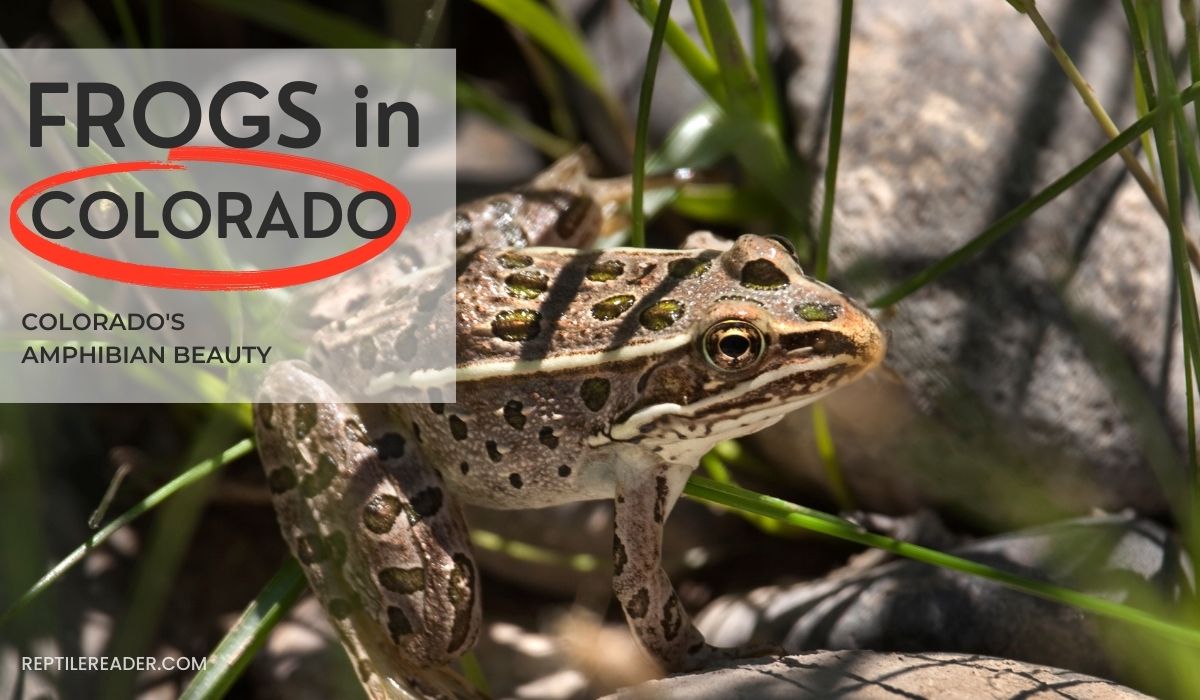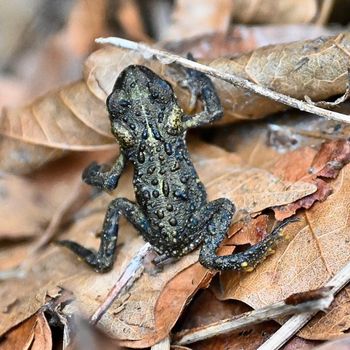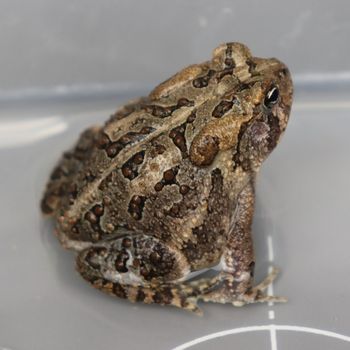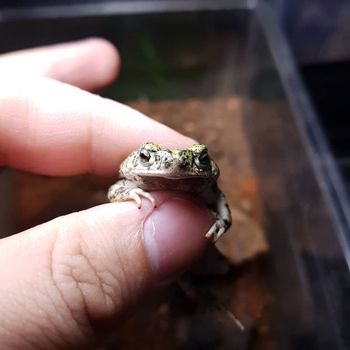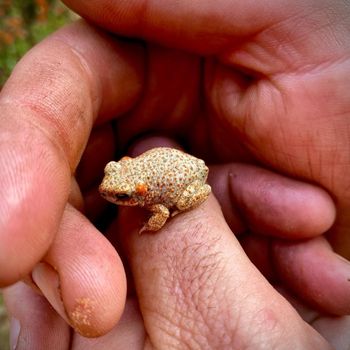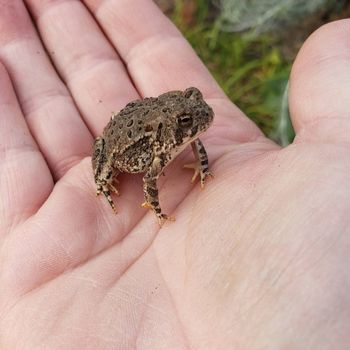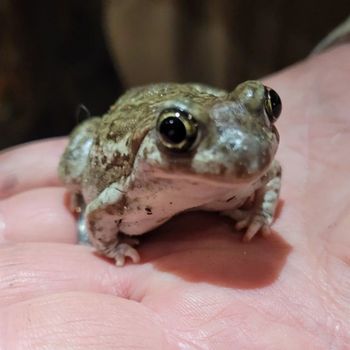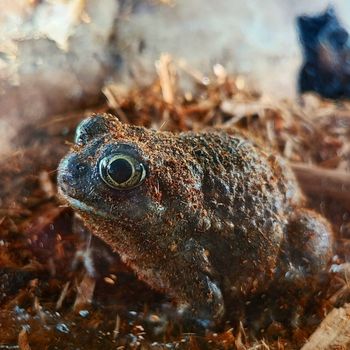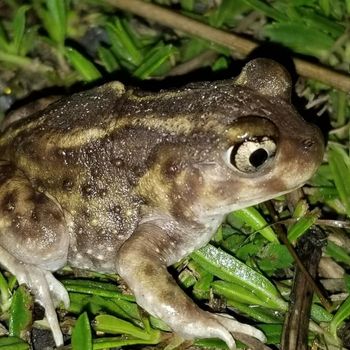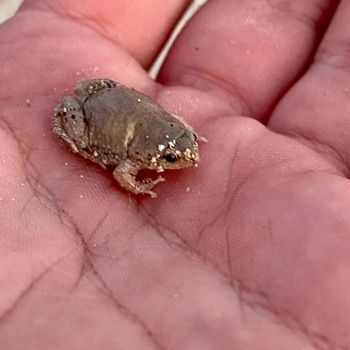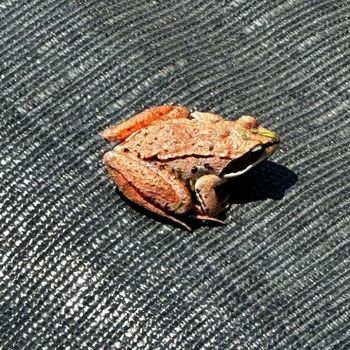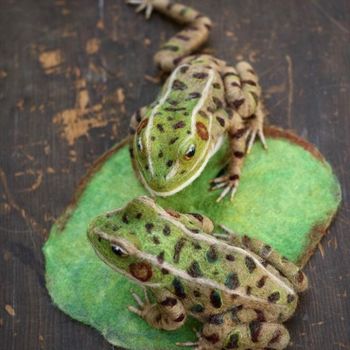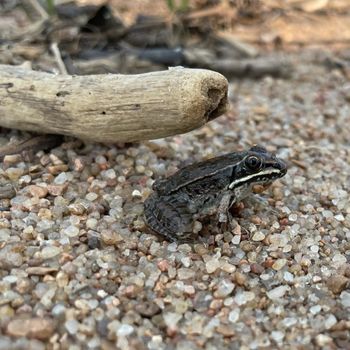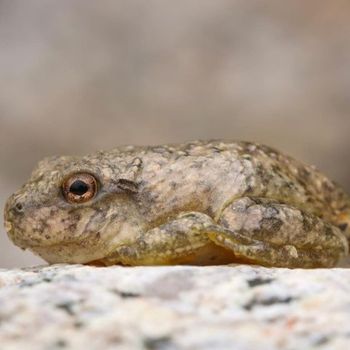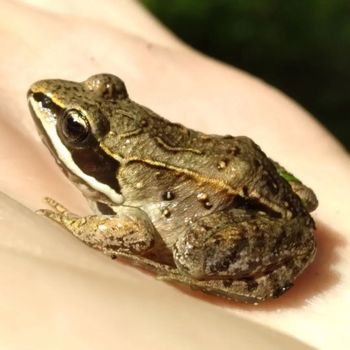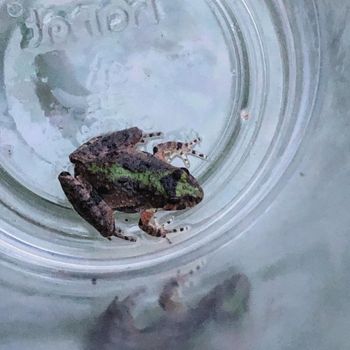Frogs in Colorado: Colorado’s Amphibian Beauty
Isn’t it amazing how many different species of our hopping friends can be found in the diverse landscapes of Colorado? You’ll be surprised to know that there are 17 different species of frogs hopping around the Centennial State, each one unique and fascinating in its own way.
As a nature lover, it always excites me when I spot a new frog species on my nature hikes. Don’t worry if you can’t tell them apart just yet – that’s what this blog is for! In the following paragraphs, we’ll be taking a look at each of these fascinating frog species and sharing some interesting tidbits about them.
So, grab your binoculars and let’s dive into the world of Colorado’s frogs! You never know, you might just spot one of these elusive amphibians on your next adventure through Colorado’s beautiful wilderness!
| # | Name | Details | Image |
| 1 | Western Toad (Bufo boreas) |
|  |
| 2 | Great Plains Toad (Anaxyrus cognatus) |
| 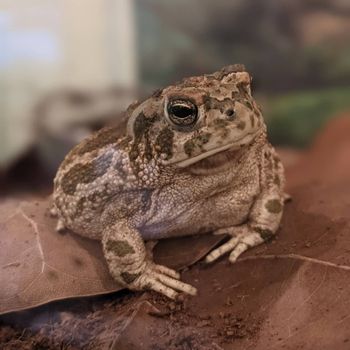 |
| 3 | Western Green Toad (Bufotes viridis) |
|  |
| 4 | Red-spotted Toad (Anaxyrus punctatus) |
| 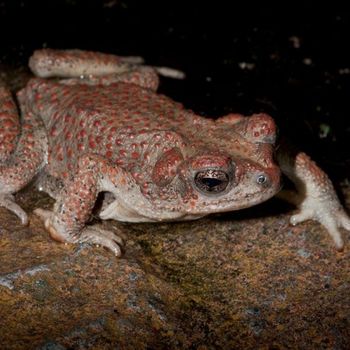 |
| 5 | Woodhouse’s Toad (Anaxyrus woodhousii) |
|  |
| 6 | Plain Spadefoot Toad (Spea bombifrons) |
| 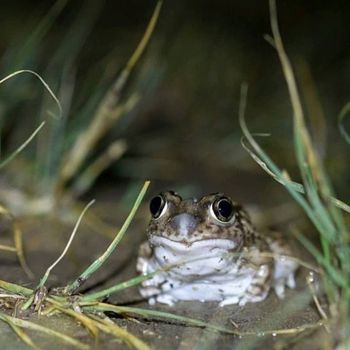 |
| 7 | Great Basin Spadefoot Toad (Spea intermontana) |
| 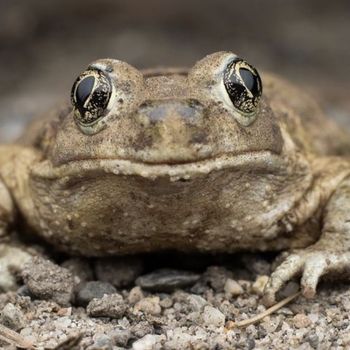 |
| 8 | Mexican Spadefoot Toad (Spea multiplicata) |
| 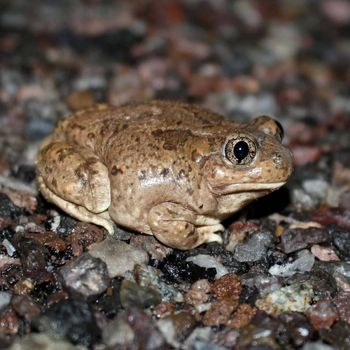 |
| 9 | Couch’s Spadefoot Toad (Scaphiopus couchii) |
| 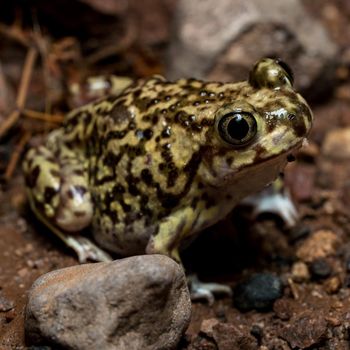 |
| 10 | Western Narrow-mouthed Toad (Gastrophryne olivacea) |
| 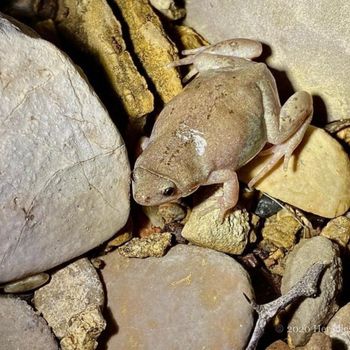 |
| 11 | American Bullfrog (Lithobates catesbeianus) |
| 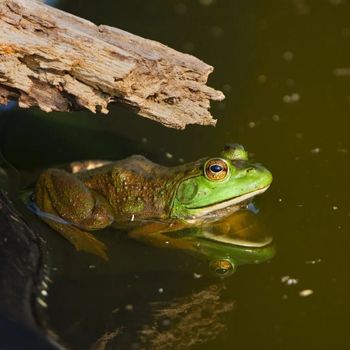 |
| 12 | Wood Frog (Rana sylvatica) |
| 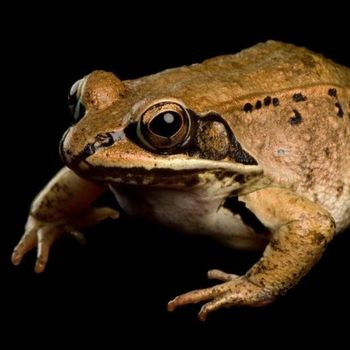 |
| 13 | Northern Leopard Frog (Rana pipiens) |
| 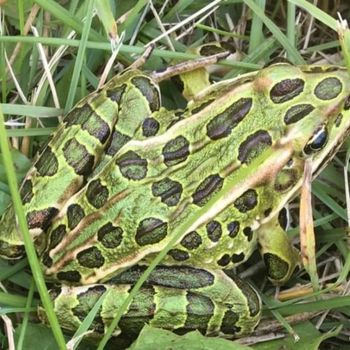 |
| 14 | Plains Leopard Frog (Lithobates blairi) |
| 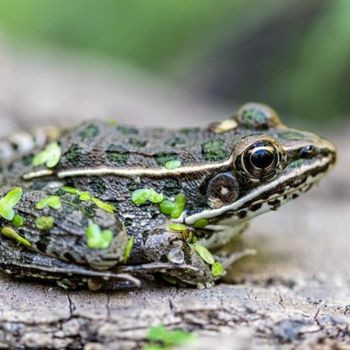 |
| 15 | Canyon Tree Frog (Hyla arenicolor) |
| 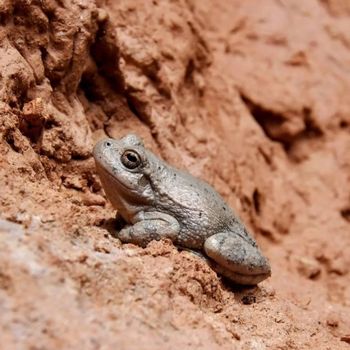 |
| 16 | Boreal Chorus Frog (Pseudacris maculata) |
| 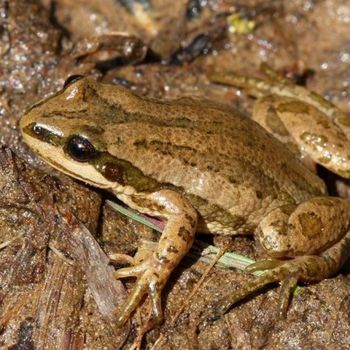 |
| 17 | Northern Cricket Frog (Acris crepitans) |
| 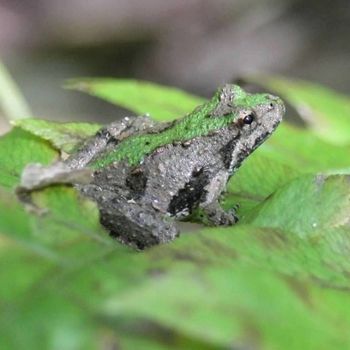 |
17 Frog Species You Can Find in Colorado
Get ready to dive deep into the lives of 17 incredible frog species that call Colorado their home, showcasing their unique adaptations and remarkable behaviors.
1. Western Toad
- Scientific Name: Bufo boreas
- Common Name: Western toad
- Size: 3-5 inches (7.6-12.7 cm)
- Color & Pattern: Brown, gray, green, or olive with dark blotches; light dorsal stripe
- Natural Habitat: Forests, meadows, wetlands, and grasslands
- Geographic Range: Western north america (from alaska to mexico)
- Diet: Insects, spiders, worms, small invertebrates
- Reproduction: Breeds in freshwater habitats, lays eggs in long strings
- Vocalization: Low-pitched short trills by males during breeding
- Adaptation: Glands secrete toxin, can breed in ephemeral ponds
- Conservation Status: Near threatened
This small yet fascinating creature ranges from 3 to 5 inches in size, boasting a captivating palette of brown, gray, green, or olive hues, adorned with dark blotches and a striking light dorsal stripe. Their nocturnal nature adds a certain air of mystery, as they dig burrows and hibernate during the biting winter months.
Making their homes in forests, meadows, wetlands, and grasslands, these toads have claimed an extensive territory spanning western North America—from the frosty expanse of Alaska to the sun-soaked stretches of Mexico. Known for their carnivorous appetite, Western Toads feast on insects, spiders, worms, and other small invertebrates, ensuring a balanced ecosystem in their diverse habitats. The low-pitched short trills of males during breeding season prove they are nothing if not romantic.
These fascinating creatures have uniquely adapted to their environment; glands in their skin secrete a powerful toxin to ward off predators, and their ability to breed in ephemeral ponds showcases their resilience. However, Western Toads are currently considered near threatened, emphasizing the need for diligent conservation efforts. Their captivating story serves as a stark reminder for us to appreciate the beauty and complexity of the wild.
2. Great Plains Toad
- Scientific Name: Anaxyrus cognatus
- Common Name: Great plains toad
- Size: 3-4.5 inches (7.5-11.4 cm)
- Color & Pattern: Green or brown with dark blotches; a white stripe down the center of the back
- Natural Habitat: Grasslands, sagebrush, floodplains
- Geographic Range: Central north america (southern canada to mexico)
- Diet: Insects, spiders, small invertebrates
- Reproduction: Breeds in temporary pools, lays eggs in long strings
- Vocalization: Multi-trill call by males during breeding
- Adaptation: Thick skin to minimize water loss, explosive breeding during rains
- Conservation Status: Least concern
The fascinating Anaxyrus cognatus, commonly known as the Great Plains Toad, boasts a captivating appearance with its distinct green or brown hues and dark blotches adorning its 3-4.5-inch body. This charming creature also features a striking white stripe running down the center of its back, making it a truly captivating sight in the wild.
Roaming across the vast grasslands, sagebrush, and floodplains of Central North America, these captivating amphibians have an insatiable appetite for insects, spiders, and small invertebrates. The alluring melodies of their multi-trill calls echo through the air, as males serenade their potential mates during breeding season in temporary pools where they lay their eggs in long strings.
Notable for their thick skin, designed to minimize water loss, the Great Plains Toad adapts to its environment by employing explosive breeding during rains and burrowing in the soil to aestivate during dry periods. With a current conservation status of “Least Concern,” we can continue to marvel at these extraordinary toads and their remarkable abilities.
3. Western Green Toad
- Scientific Name: Bufotes viridis
- Common Name: Western green toad
- Size: 1.5-2 inches (4-5 cm)
- Color & Pattern: Green to grayish-green with dark speckles or spots
- Natural Habitat: Mediterranean scrublands, grasslands, and temporary ponds
- Geographic Range: Southern europe to western asia
- Diet: Insects, spiders, and small invertebrates
- Reproduction: Breeds in temporary and permanent freshwater ponds, lays eggs in single strings
- Vocalization: Soft trill or buzz by males during breeding
- Adaptation: Warty skin secretes toxins, nocturnal behavior, strong limbs for digging
- Conservation Status: Least concern
These petite creatures, measuring a mere 1.5-2 inches (4-5 cm), flaunt a dazzling green to grayish-green complexion adorned with dark speckles or spots. You’ll find them nestled in Mediterranean scrublands, grasslands, and temporary ponds, scattered across southern Europe to western Asia.
At night, these fascinating toads emerge to feast on insects, spiders, and small invertebrates, serenading the evening with soft trills and buzzes. Their warty skin harbors toxic secrets that deter predators while their strong limbs enable them to dig and hide. Temporary and permanent freshwater ponds serve as an ideal stage for breeding, where females lay eggs in single strings reminiscent of delicate necklaces.
Western Green Toads shimmer like jewels in their ecosystems, providing vital pest control in agricultural areas. Interestingly, the darker males often win the heart of the females. And fear not, for these small wonders are currently deemed of least concern for conservation status, ensuring their presence will continue to enchant future generations.
4. Red-spotted Toad
- Scientific Name: Anaxyrus punctatus
- Common Name: Red-spotted toad
- Size: 1.5-3.5 inches (3.8-8.9 cm)
- Color & Pattern: Gray, olive or greenish-brown with red or orange spots
- Natural Habitat: Desert streams, pools, springs, riverbanks
- Geographic Range: Southwestern united states and central mexico
- Diet: Insects, spiders, various arthropods
- Reproduction: Breeds in temporary or seasonal water sources, lays eggs attached to small stones or vegetation
- Vocalization: Short, high-pitched call by males during breeding
- Adaptation: Adapted to arid environments, can survive long periods without water
- Conservation Status: Least concern
This fascinating creature measures between 1.5-3.5 inches and thrives along desert streams, pools, springs, and riverbanks throughout the southwestern United States and Central Mexico.
A master of arid survival, this toad has adapted remarkably well to its dry environment, performing awe-inspiring feats like reabsorbing water from its own urine and enduring extended periods without water. Agile and intelligent, the Red-spotted Toad relies on a diet of insects, spiders, and various arthropods to sustain itself in the state of Colorado.
During breeding season, Red-spotted Toads are often heard serenading their mates with a soft, high-pitched call. They reproduce in seasonal water sources, laying their eggs on tiny stones or vegetation. With a conservation status of “Least Concern” and fascinating interbreeding abilities, these toads will likely charm generations to come.
5. Woodhouse’s Toad
- Scientific Name: Anaxyrus woodhousii
- Common Name: Woodhouse’s toad
- Size: 2-5 inches (5-12.7 cm)
- Color & Pattern: Gray, green, or brown with dark blotches, light-colored midline stripe
- Natural Habitat: Grasslands, shrublands, forests, agricultural fields
- Geographic Range: Western north america (from southern canada to northern mexico)
- Diet: Insects, spiders, and other small invertebrates
- Reproduction: Breeds in temporary or permanent bodies of water, lays eggs in long strings
- Vocalization: Males produce a long, nasal trill during breeding season
- Adaptation: Parotoid glands secrete bufotoxin, good burrowers
- Conservation Status: Least concern
Anaxyrus woodhousii, commonly known as Woodhouse’s Toad, is a small and adaptable amphibian found throughout western North America – from the fields of southern Canada to the forests of northern Mexico. Measuring 2-5 inches in length, this friendly toad boasts a mottled gray, green, or brown appearance with dark blotches and a distinctive light-colored midline stripe down its back.
This resourceful creature thrives in a range of habitats, from grasslands and shrublands to forests and agricultural fields. They enjoy a hearty diet of insects, spiders, and other small invertebrates. During the breeding season, male Woodhouse’s toads serenade their potential mates with a long, nasal trill, laying their eggs in lengthy strings within temporary or permanent bodies of water.
The Woodhouse’s Toad is well adapted for survival, possessing parotoid glands that secrete a potent toxin called bufotoxin to deter predators. They are also adept burrowers, easily creating underground shelters. Although their conservation status is currently listed as “least concern,” their populations have been impacted by pesticide use. This versatile and resilient toad continues to play an essential role in our diverse North American ecosystems.
6. Plain Spadefoot Toad
- Scientific Name: Spea bombifrons
- Common Name: Plain spadefoot toad
- Size: 1.5-2.5 inches (3.8-6.4 cm)
- Color & Pattern: Brown or gray with faint markings, dark v-shaped mark on snout
- Natural Habitat: Grasslands, desert scrub, sandy areas
- Geographic Range: Southwestern united states, northern mexico
- Diet: Insects, arthropods, small invertebrates
- Reproduction: Breeds in temporary pools, lays eggs in water
- Vocalization: Low, snoring chorus by males during breeding
- Adaptation: Metamorphosis can occur as quickly as 8 days, spade-like structure on hind feet for digging
- Conservation Status: Least concern
Introducing the fascinating Spea bombifrons – or as it’s more commonly known, the Plain Spadefoot Toad. This enigmatic amphibian measures a modest 1.5-2.5 inches in length and sports a distinctive, neutral-toned palette of brown or gray, adorned with faint markings and a dark V-shaped pattern on its snout. The true magic, however, lies in its nighttime activities and unique habitat preferences.
Inhabiting the southwestern United States and northern Mexico, the Plain Spadefoot thrives within grasslands, desert scrub, and sandy locales. Their specialized adaptations include a spade-like structure on their hind feet, perfect for digging, and a metamorphosis period capable of occurring within a swift eight days! And when hunger pangs strike, they feast on a scrumptious menu of insects, arthropods, and small invertebrates.
While currently of least concern in conservation status, these toads still offer a noteworthy performance. Males serenade potential partners with a low snoring chorus during breeding season, sparking explosive, rainstorm-prompted events and egg-laying within temporary pools. As nocturnal creatures, they keep a low profile, aestivating during dry spells. Discover the charm and resilience of the Plain Spadefoot Toad, a remarkable desert dweller.
7. Great Basin Spadefoot Toad
- Scientific Name: Spea intermontana
- Common Name: Great basin spadefoot toad
- Size: 1.5-3 inches (3.8-7.6 cm)
- Color & Pattern: Green to brown with dark spots, light-colored stripe along spine
- Natural Habitat: Sagebrush, grasslands, desert scrub
- Geographic Range: Southwestern canada, western us
- Diet: Insects, spiders, small invertebrates
- Reproduction: Breeds in temporary pools, lays eggs attached to vegetation
- Vocalization: Males make low-pitched chirping noises during breeding
- Adaptation: Spade-like appendages on hind feet for digging, can secrete toxin from skin
- Conservation Status: Least concern
Donning hues of green to brown, decorated with mysterious dark spots and an elegant light-colored stripe down its spine, this small creature measures just between 1.5-3 inches. Roaming the sagebrush, grasslands, and desert scrub landscapes of Colorado, this petite amphibian can be found spreading its charm throughout the southwestern expanses of Canada and the western US.
Always on the hunt for delicious insects, spiders, and small invertebrates, the Great Basin Spadefoot Toad knows how to survive. But once it’s time for reproduction, this little wonder seeks out temporary pools to lay its eggs, carefully attaching them to nearby vegetation. During the breeding season, males serenade their partners with low-pitched, harmonious chirping noises.
Possessing impressive adaptations, the Spea intermontana is well-equipped for its environment. Its hind feet showcase spade-like appendages for digging, and they can even secrete toxins to discourage predators. This extraordinary toad goes into aestivation during dry periods, shedding its skin in a unique “cocoon” during emergence. With a conservation status of “least concern”, it seems, for now, the enchanting Great Basin Spadefoot Toad is here to stay.
8. Mexican Spadefoot Toad
- Scientific Name: Spea multiplicata
- Common Name: Mexican spadefoot toad
- Size: 1.5-3.5 inches (4-9 cm)
- Color & Pattern: Green, brown or gray with dark mottling or speckling
- Natural Habitat: Semi-arid habitats, grasslands, deserts
- Geographic Range: Southwestern united states and northern mexico
- Diet: Insects, spiders, small terrestrial invertebrates
- Reproduction: Breeds in temporary pools, lays eggs in shallow water
- Vocalization: Short, low-pitched, nasal-sounding calls by males during breeding
- Adaptation: Metatarsal spades for burrowing, highly efficient water absorption
- Conservation Status: Least concern
Meet the Spea multiplicata, also known as the Mexican Spadefoot Toad. This petite amphibian, measuring 1.5 to 3.5 inches (4 to 9 cm), is garbed in an array of green, brown, or gray shades with an intricate dance of dark mottling or speckling adorning its skin. This stylish creature calls home in the semi-arid habitats, grasslands, and deserts of the Southwestern United States and northern Mexico.
In the pursuit of food, the Mexican Spadefoot Toad feasts on insects, spiders, and other small terrestrial invertebrates. Males serenade females with short, low-pitched, nasal-sounding calls during breeding season, and the females lay their eggs in shallow waters. Metatarsal spades enhance the ability to burrow, and highly-efficient water absorption keeps them hydrated.
Our friend, the Spadefoot Toad, is a master of adaptation. During the dry spells of their arid habitats, they estivate underground and emerge after heavy rain to breed. With a conservation status of ‘Least Concern,’ let us revel in the knowledge that these fascinating creatures continue to thrive in their natural home.
9. Couch’s Spadefoot Toad
- Scientific Name: Scaphiopus couchii
- Common Name: Couch’s spadefoot toad
- Size: 1.5-3.5 inches (3.8-8.9 cm)
- Color & Pattern: Brown, gray, or green with dark spots or blotches
- Natural Habitat: Deserts, grasslands, sandy soil areas
- Geographic Range: Southwestern united states, central and northern mexico
- Diet: Insects, spiders, small invertebrates
- Reproduction: Breeds in temporary pools after heavy rains, lays eggs in water
- Vocalization: Short, explosive, trilling call by males during breeding
- Adaptation: Spade-like projections on hind feet for burrowing, estivation during dry periods
- Conservation Status: Least concern
A master of camouflage and adaptation, this unique species is woven into the diverse tapestry of deserts, grasslands, and sandy soil areas in the southwestern United States, as well as Central and Northern Mexico.
Devouring a banquet of insects, spiders, and small invertebrates, Couch’s Spadefoot Toad leads a slyly nocturnal lifestyle, emerging from its burrows during the arresting beauty of summer rains. Males court their mates with a short, explosive, trilling serenade during their enchanting breeding rituals in temporary pools created by the season’s downpours. The next generation is then lovingly laid in these transient aquatic nurseries.
Remarkably, this toad-hero can absorb water through its skin, a skill that is harmoniously complemented by spade-like projections on its hind feet for burrowing into the earth during estivation. These beautiful adaptations ensure its survival in often harsh environments. Currently listed as a species of least concern, the mysterious and captivating Couch’s Spadefoot Toad continues to captivate and inspire those lucky enough to encounter it.
10. Western Narrow-mouthed Toad
- Scientific Name: Gastrophryne olivacea
- Common Name: Western narrow-mouthed toad
- Size: 1.1-1.5 inches (2.8-3.8 cm)
- Color & Pattern: Brown, gray, or olive green with a dark stripe down the center of the back
- Natural Habitat: Grasslands, woodland areas, desert environments
- Geographic Range: Southwestern united states (texas, arizona, oklahoma) and northern mexico
- Diet: Ants, termites, beetles, and other small invertebrates
- Reproduction: Breeding occurs in temporary rain pools, lays up to 1000 eggs
- Vocalization: Males make short “buzzing” or “beeping” calls during breeding season
- Adaptation: Elastic skin with wedge-shaped head for burrowing, can secrete toxic substance
- Conservation Status: Least concern
Sitting discreetly in the wild grasslands, woodland areas, or desert environments of the Southwestern United States and Northern Mexico, the Western Narrow-mouthed Toad (Gastrophryne olivacea) exhibits a fascinating array of colors and patterns. With its size ranging between 1.1-1.5 inches (2.8-3.8 cm), this charming creature displays a perfect blend of brown, gray, or olive green background hues, adorned with a dark stripe elegantly cascading down the center of its back.
The Western Narrow-mouthed Toad embarks on a nocturnal journey each night, feeding on ants, termites, beetles, and an assortment of other small invertebrates. During the breeding season, males serenade their mates with intriguing buzzing and beeping vocalizations while congregating in temporary rain pools, where they lay up to 1000 eggs. Interestingly, it is the torrential rainfall that triggers this fascinating dance of love and life.
Mother nature has bestowed the power of adaption on this marvelous amphibian which has developed a wedge-shaped head and elastic skin perfect for burrowing in its quest to find sustenance. Additionally, it possesses a secret defense mechanism: a toxic substance that can be secreted when threatened. Listed under the standard of “Least Concern” for conservation status, the Western Narrow-mouthed Toad is a notable nocturnal wonder, thriving and enchanting those who witness its beauty.
11. American Bullfrog
- Scientific Name: Lithobates catesbeianus
- Common Name: American bullfrog
- Size: 3.5-6 inches (9-15 cm)
- Color & Pattern: Green to brown with dark spots and patterns
- Natural Habitat: Ponds, lakes, marshes, slow-moving streams
- Geographic Range: Eastern and central united states, canada, mexico, introduced worldwide
- Diet: Fish, crustaceans, insects, small mammals, birds, other amphibians
- Reproduction: Breeds in aquatic habitats, lays eggs in flat surfaces on water
- Vocalization: Deep, low-pitched calls by males during breeding
- Adaptation: Highly adaptable, strong legs for jumping and swimming
- Conservation Status: Least concern
Immerse yourself in the world of the American Bullfrog (Lithobates catesbeianus), a striking amphibian with a size ranging from 3.5 to 6 inches (9-15 cm). Adorned in a rich palette of green to brown, they exhibit dark spots and patterns which serve as excellent camouflage within their habitat. These aquatic creatures can leap and swim with grace and strength, due to their powerful legs.
Dwelling in the eastern and central United States, Canada, Mexico, and various regions around the world, they call ponds, lakes, marshes, and slow-moving streams their home. They satiate their hunger with a diverse diet of fish, crustaceans, insects, small mammals, birds, and other amphibians. The American Bullfrog is even known to be cannibalistic, predating on native species in introduced areas.
During breeding season, male Bullfrogs exclaim deep, low-pitched calls to attract mates, resulting in them laying their eggs in flat surfaces on the water for successful reproduction. Despite being a significant predator, their conservation status remains of least concern and they continue to thrive, showcasing their impressive adaptability. Delve deeper into the world of this fascinating amphibian, and uncover more about its unique quirks and captivating existence.
12. Wood Frog
- Scientific Name: Rana sylvatica
- Common Name: Wood frog
- Size: 1.4-3.7 inches (3.5-7.6 cm)
- Color & Pattern: Tan or brown with dark mask around eyes and back leg stripe
- Natural Habitat: Woodlands, bogs, swamps
- Geographic Range: North america, from alaska to new england, and south to northern georgia
- Diet: Insects, spiders, worms, slugs, snails
- Reproduction: Breeds in freshwater habitats, lays eggs in clusters attached to vegetation
- Vocalization: Males make a duck-like quacking sound during breeding
- Adaptation: Ability to freeze and thaw as a means to survive cold conditions
- Conservation Status: Least concern
Meet the captivating Rana sylvatica, commonly known as the Wood Frog, a forest-dwelling amphibian with an exquisite flair for blending into its surroundings. Sporting a fashionable tan or brown, adorned with a dark mask around its eyes, and a sleek stripe on its back legs, this petite creature ranges from 1.4-3.7 inches in size (3.5-7.6 cm). Its range spans North America, from the bustling wilds of Alaska to New England, with southern settlers in northern Georgia.
A gourmand of small delicacies, the Wood Frog feasts on a varied menu consisting of insects, spiders, worms, slugs, and snails. Its breeding rituals take place in the serene freshwater habitats it calls home, laying its precious eggs in clusters that find attachment on submerged vegetation. The debonair males serenade potential mates with duck-like quacking during these amorous encounters.
The true pièce de résistance of this incredible species is their unparalleled ability to freeze and thaw, permitting survival in harsh, cold conditions. Amidst this extraordinary talent, the Wood Frog is not considered at risk with a conservation status deemed of least concern. The fascinating life of the Wood Frog unfolds with eggs hatching within mere weeks, showcasing their resilient nature and true wonder.
13. Northern Leopard Frog
- Scientific Name: Rana pipiens
- Common Name: Northern leopard frog
- Size: 2.0-4.3 inches (5.1-11 cm)
- Color & Pattern: Green or brown with dark spots circled by a lighter border
- Natural Habitat: Marshes, swamps, grasslands, wetlands
- Geographic Range: Canada and the united states (alaska to new mexico)
- Diet: Insects, spiders, small crustaceans, other invertebrates
- Reproduction: Breeds in shallow, well-vegetated freshwater habitats, lay eggs in clusters attached to vegetation
- Vocalization: Snore-like call by males during breeding
- Adaptation: Long, powerful legs for jumping, partially webbed hind feet for swimming
- Conservation Status: Least concern
These captivating creatures are perfectly suited for life in marshes, swamps, grasslands, and wetlands, stretching from Alaska to New Mexico in North America. Their partially webbed hind feet allow them to swim gracefully, while their long, powerful legs support impressive jumping abilities.
With a main diet of insects, spiders, small crustaceans, and other invertebrates, these voracious eaters keep their habitats in Colorado lively. During breeding season, these frogs settle in shallow, well-vegetated freshwater habitats, and females lay eggs in clusters attached to vegetation. To attract a mate, male frogs serenade their companions with a unique, snore-like vocalization.
Remarkably, the Northern Leopard Frog is capable of surviving being frozen, an unparalleled adaptation contributing to their classification as “Least Concern” in conservation statuses. However, it is worth noting that habitat loss may lead to a decline in future populations. Overall, these fascinating frogs continue to enchant us with their beauty, resilient nature, and captivating behaviors.
14. Plains Leopard Frog
- Scientific Name: Lithobates blairi
- Common Name: Plains leopard frog
- Size: 2-3.5 inches (5-9 cm)
- Color & Pattern: Green or brown with prominent dark spots and light-colored dorsolateral ridges
- Natural Habitat: Wetlands, prairies, grasslands, ponds, and streams
- Geographic Range: Central united states, texas to nebraska, mississippi to arizona
- Diet: Insects, spiders, centipedes, and various aquatic invertebrates
- Reproduction: Breeds in still or slow-moving water, lays eggs in clusters attached to submerged vegetation
- Vocalization: Calls consist of a series of low, guttural rumbles and croaks
- Adaptation: Powerful legs for swimming and leaping, ability to tolerate drier habitats
- Conservation Status: Least concern
A master of agility, its powerful legs provide exceptional swimming and leaping capabilities, as it gracefully navigates wetlands, prairies, and grasslands throughout the Central United States – from Texas to Nebraska, and Mississippi to Arizona.
Thriving in still or slow-moving water, these feisty frogs lay their eggs in clusters, hidden amidst submerged vegetation. With an appetite for insects, spiders, centipedes, and aquatic invertebrates, their guttural rumbles and croaks reveal their lively presence, making them an essential contributor to a thriving ecosystem.
These versatile creatures boast an ability to regenerate lost appendages, making them vital indicator species for ecosystem health. They are resilient, tolerating drier habitats and currently classified under the “Least Concern” for conservation status – a fascinating, dynamic, and significant component of our natural world.
15. Canyon Tree Frog
- Scientific Name: Hyla arenicolor
- Common Name: Canyon tree frog
- Size: 1.5-2.5 inches (3.8-6.3 cm)
- Color & Pattern: Gray, brown or green with irregular dark markings
- Natural Habitat: Canyons, streams, ponds, rocky environments
- Geographic Range: Southwestern united states, mexico
- Diet: Insects, spiders, small invertebrates
- Reproduction: Breeds in temporary or permanent water bodies, lays eggs on submerged vegetation
- Vocalization: Short, raspy calls by males during breeding
- Adaptation: Ability to change color, adhesive toe pads for climbing
- Conservation Status: Least concern
Its gray, brown, or green skin adorned with irregular dark markings allows it to seamlessly blend into the rocky landscapes, canyons, and water bodies of its southwestern United States and Mexican habitat.
These expert climbers feast upon insects, spiders, and small invertebrates during the cover of night. Canyon Tree Frogs utilize their adaptive abilities in color-changing and adhesive toe pads for exceptional navigation of their surroundings. Males attract their mates with short, raspy calls, breeding in temporary or permanent waters, and lay their eggs on submerged vegetation.
Remarkably, these high-elevation dwellers can thrive up to 8,000 feet. Currently enjoying a conservation status of “Least Concern,” the nocturnal Canyon Tree Frog remains a fascinating embodiment of adaptability and resilience.
16. Boreal Chorus Frog
- Scientific Name: Pseudacris maculata
- Common Name: Boreal chorus frog
- Size: 0.8-1.6 inches (2-4 cm)
- Color & Pattern: Gray, brown or green with dark stripes on the back and sides
- Natural Habitat: Marshes, grasslands, wet meadows
- Geographic Range: Northwestern united states and canada
- Diet: Small insects, spiders, and other invertebrates
- Reproduction: Breeds in shallow water, lays eggs attached to vegetation
- Vocalization: Series of ascending, short trills
- Adaptation: Able to change color for camouflage, strong climbers
- Conservation Status: Least concern
Hidden in the marshes, grasslands, and wet meadows of northwestern United States and Canada, the small creature with a big voice, the Boreal Chorus Frog, thrives. Although diminutive in size, measuring only 0.8-1.6 inches, their distinct colors and patterns of gray, brown, or green with dark stripes on the back and sides allow them to stand out in their environment. Pseudacris maculata, as they’re known in the scientific community, have an impressive ability to change their color for camouflage and are remarkable climbers.
Surviving primarily on small insects, spiders, and other invertebrates, these talented amphibians lay their eggs attached to vegetation in shallow water, filling the surrounding area with a series of ascending, short trills to establish their presence. Fascinatingly, these frogs have developed concentrated antifreeze proteins that allow them to endure freezing temperatures – a vital adaptation in their often chilly habitat.
Fortunately, the conservation status of this Colorado resident is deemed the least concern due to their versatile adaptations and stable population, ensuring these interesting creatures remain an essential part of their ecosystem.
17. Northern Cricket Frog
- Scientific Name: Acris crepitans
- Common Name: Northern cricket frog
- Size: 0.6-1.5 inches (1.5-3.8 cm)
- Color & Pattern: Brown or green with dark spots or bands
- Natural Habitat: Shallow, permanent waters with vegetation
- Geographic Range: Eastern united states (minnesota to texas)
- Diet: Insects, spiders, small invertebrates
- Reproduction: Breeds in shallow waters, eggs attached to plants
- Vocalization: Distict chirping or clicking calls made by males during breeding season
- Adaptation: Powerful legs for jumping, freeze tolerance
- Conservation Status: Least concern
These tiny amphibians, ranging from 0.6 to 1.5 inches in length, display charming brown or green hues adorned with dark spots or bands. Hailing from the eastern United States, these little acrobats can be found amid shallow, permanent waters where vegetation thrives.
These remarkable frogs boast powerful legs, enabling them to leap up to six feet in a single jump! Northern Cricket Frogs primarily feast on insects, spiders, and small invertebrates. During breeding season, the males serenade their mates with distinct chirping or clicking calls, laying their eggs in shallow waters attached to various plants.
With a conservation status of Least Concern, the Northern Cricket Frog is a thriving species. One of their most fascinating traits is their incredible freeze tolerance, making them well-adapted to their environment. With such unique features, the Northern Cricket Frog is undoubtedly one of nature’s captivating wonders.
Nearby States:
Are There Any Amphibian Species Found Both in Maine and Colorado?
Maine and Colorado each host unique amphibian species due to their distinct habitats, but similarities do exist. Some species, like frogs native to maine amphibians, may share distant relatives with species in Colorado, although typically different ecological conditions lead to variations in the specific amphibians found in both states.
What Unique Species of Frogs Can Be Found in Colorado?
While Colorado is not known for its diverse frog population, there are still several fascinating frogs in ohio species that can be found in the state. Some of these unique species include the canyon tree frog, northern leopard frog, and the boreal chorus frog. These frogs can be found in various habitats across Colorado.
Final Words
In summary, Colorado boasts a remarkable array of 17 diverse frog species, displaying a kaleidoscope of colors, patterns, and unique adaptations. Embark on a fascinating journey through their habitats, appreciating their distinctive vocalizations, and uncover the secret lives of these magnificent amphibians that grace the state of Colorado. From the vibrant mountain meadows to lush wetlands, these species play crucial roles in their ecosystems, from controlling insect populations to serving as indicators of environmental health. While Colorado’s frogs share some similarities with frogs native to Maine, such as their reliance on aquatic habitats, they are uniquely shaped by the distinct climate and geography of the Rocky Mountain region. Exploring both regions reveals the incredible adaptability and diversity of frogs across varying landscapes.

